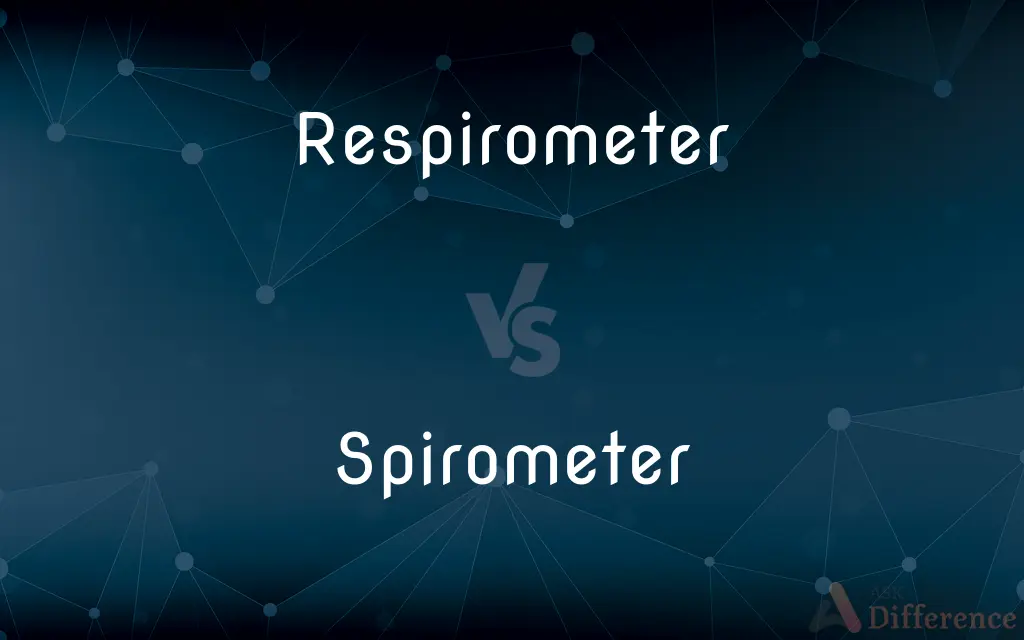Respirometer vs. Spirometer — What's the Difference?
By Urooj Arif & Fiza Rafique — Updated on March 20, 2024
"Respirometer" measures the rate of respiration in organisms, while "Spirometer" assesses lung function in humans by measuring air volume and flow.

Difference Between Respirometer and Spirometer
Table of Contents
ADVERTISEMENT
Key Differences
A respirometer is a device used primarily in scientific research to measure the rate of respiration of living organisms. It can be used for small animals, plants, or even cellular respiration in a laboratory setting. In contrast, a spirometer is a medical instrument designed to evaluate lung function in humans by measuring the volume of air inhaled and exhaled and the speed of the breath. Spirometry, the test performed with a spirometer, is crucial in diagnosing and monitoring conditions like asthma, chronic obstructive pulmonary disease (COPD), and other respiratory disorders.
Respirometers are versatile in their application, allowing for the study of metabolic rates under different conditions, such as changes in temperature, activity levels, or exposure to various substances. This makes respirometers valuable tools in biological research, environmental studies, and educational settings. On the other hand, spirometers are specifically tailored for clinical use, providing detailed measurements of lung capacity and airflow that are essential for diagnosing respiratory conditions, assessing the effect of medications, and monitoring disease progression or response to treatment.
The functionality of respirometers can vary depending on the type and purpose, but they generally measure gas exchange to infer respiration rates. This can involve capturing the change in gas volume or pressure in a closed system as the organism respires. Spirometers, however, specifically measure lung volumes and capacities, such as tidal volume, vital capacity, and forced expiratory volume, through direct inhalation and exhalation into the device. These measurements are critical in assessing how well the lungs are functioning and identifying potential abnormalities.
While both devices are related to the process of respiration, their applications, audiences, and measurement specifics differ significantly. Respirometers serve a broader scientific purpose, applicable to a wide range of organisms for research and educational purposes. In contrast, spirometers have a clinical application focused on human lung health, playing a critical role in respiratory healthcare.
In summary, while both respirometers and spirometers are essential tools in their respective fields for studying and understanding respiration, their specific uses, from scientific research to clinical diagnosis and treatment of lung diseases, highlight their distinct purposes and functionalities.
ADVERTISEMENT
Comparison Chart
Purpose
Measures respiration rate in organisms
Assesses lung function in humans
Application
Scientific research, environmental studies, education
Clinical settings, diagnosing and monitoring respiratory conditions
Measurement
Oxygen consumption or CO2 production
Air volume and flow during inhalation and exhalation
Key Uses
Studying metabolic rates, effects of environmental changes
Diagnosing asthma, COPD; assessing treatment effectiveness
Audience
Researchers, educators, biologists
Healthcare professionals, pulmonologists
Compare with Definitions
Respirometer
Measuring metabolic activity.
The respirometer indicated an increase in the metabolic rate of the mice under warmer conditions.
Spirometer
Lung function assessment.
The spirometer test results helped diagnose her asthma.
Respirometer
Versatile organism application.
Respirometers can be used to measure respiration in both terrestrial and aquatic organisms.
Spirometer
Monitoring disease progression.
Regular spirometry checks are crucial for COPD patients to monitor lung function changes.
Respirometer
Educational tool.
In biology classes, students use respirometers to observe cellular respiration rates.
Spirometer
Evaluating treatment effectiveness.
Spirometry was used to assess the impact of the new medication on lung capacity.
Respirometer
Environmental impact studies.
Researchers used a respirometer to assess the impact of pollutants on plant respiration.
Spirometer
Respiratory health screening.
Spirometers are often used in occupational health to screen for work-related respiratory issues.
Respirometer
Gas exchange measurement.
The respirometer measured the oxygen uptake and carbon dioxide release of the soil samples.
Spirometer
Pre-surgical lung capacity evaluation.
The doctor ordered a spirometry test to evaluate his lung function before surgery.
Respirometer
A respirometer is a device used to measure the rate of respiration of a living organism by measuring its rate of exchange of oxygen and/or carbon dioxide. They allow investigation into how factors such as age, or chemicals affect the rate of respiration.
Spirometer
A spirometer is an apparatus for measuring the volume of air inspired and expired by the lungs. A spirometer measures ventilation, the movement of air into and out of the lungs.
Respirometer
An instrument for measuring the degree and nature of respiration.
Spirometer
An instrument for measuring the volume of air entering and leaving the lungs.
Respirometer
A device used to measure the rate of respiration of living organisms, such as plants or fish.
Spirometer
(medicine) An instrument for measuring the air capacity of the lungs.
Respirometer
An apparatus for supplying air to a diver under water.
Spirometer
An instrument for measuring the vital capacity of the lungs, or the volume of air which can be expelled from the chest after the deepest possible inspiration. Cf. Pneumatometer.
Spirometer
A measuring instrument for measuring the vital capacity of the lungs
Common Curiosities
Are respirometers used in human medicine?
Respirometers are not typically used in clinical settings for humans but are valuable in research contexts, including human physiology studies.
How accurate are respirometers in measuring respiration?
Respirometers can be quite accurate when calibrated and used correctly, though results may vary with the organism's size, type, and environmental conditions.
Can a spirometer be used on animals?
While spirometers are designed for humans, similar principles can be applied in veterinary medicine with specialized equipment.
Can spirometry detect lung cancer?
Spirometry primarily assesses lung function and cannot directly diagnose lung cancer, but it may help identify breathing issues that warrant further investigation.
Are there any risks associated with using a spirometer?
Spirometry is generally safe, but it may be uncomfortable or risky for individuals with certain health conditions; healthcare providers assess these risks before testing.
Can environmental factors affect respirometer readings?
Yes, factors like temperature, pressure, and the presence of certain chemicals can influence respirometer readings and should be controlled for accurate measurements.
How do researchers ensure the accuracy of respirometer measurements?
Calibration, controlling environmental variables, and using proper techniques are essential for ensuring the accuracy of respirometer measurements.
Can spirometry be used for children?
Yes, spirometry can be used for children old enough to understand and perform the test, usually around age 6 or older, with pediatric norms for interpretation.
Is training required to use a spirometer?
Proper training is essential for conducting spirometry tests accurately, including patient instruction and interpretation of results.
What's the difference between a spirometry test and a peak flow meter?
Spirometry provides detailed measurements of various lung volumes and capacities, while a peak flow meter only measures the maximum speed of exhalation.
Share Your Discovery

Previous Comparison
Temporary vs. Permanent
Next Comparison
Niacinamide vs. NicotinamideAuthor Spotlight
Written by
Urooj ArifUrooj is a skilled content writer at Ask Difference, known for her exceptional ability to simplify complex topics into engaging and informative content. With a passion for research and a flair for clear, concise writing, she consistently delivers articles that resonate with our diverse audience.
Co-written by
Fiza RafiqueFiza Rafique is a skilled content writer at AskDifference.com, where she meticulously refines and enhances written pieces. Drawing from her vast editorial expertise, Fiza ensures clarity, accuracy, and precision in every article. Passionate about language, she continually seeks to elevate the quality of content for readers worldwide.
















































